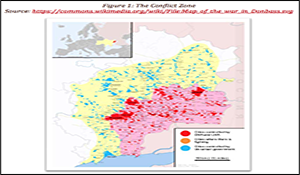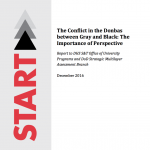The Conflict in the Donbas between Gray and Black

The Conflict in the Donbas between Gray and Black: The Importance of Perspective.
Author | Editor: Finkel, E. (University of Maryland, START).
The current case study analyzes the presence and importance of Gray Zone conflict dynamics and the employment of various instruments of power during the still ongoing conflict in Eastern Ukraine (Donbas) since its beginning in 2014. More specifically, it studies the use of various instruments of power across a number of conflict dyads, present in the conflict. The case study’s findings can better inform practitioners and analysts about the presence, content, and effectiveness of utilizing different instruments of power in the Gray Zone.
The analysis covers the participation of various entities and groups, operating in the Donbas: the governments of two states, Russia and Ukraine; the initially independent volunteer formations on the Ukrainian side; and two quasi-state insurgent entities. The analysis uncovers numerous Gray Zone interactions across several dyads, but also demonstrated the limits of the Gray Zone both as a set of empirical actions and as a conceptual approach to understanding the conflict itself. This study shows that Gray Zone activities exist to varying degrees in all dyads, but they are most pronounced in the Ukrainian versus Russian governments dyad.
In addition to uncovering and analyzing the existing Gray Zone dynamics, the case study also argues that Special Operation Forces should pay substantial attention to preexisting perceptions, media framings and worldviews in devising general Gray Zone policies and actions. Thus, the analysis shows that the classification of the conflict in the Donbas as a Gray Zone conflict is possible only if the emphasis is put on the interactions between the Russian and the Ukrainian governments as the primary driver and cause of the violence. However, if the attention is shifted towards domestic, rather than geopolitical causes of the violence, the conflict is more properly classified as a Black Zone conflict. These differences in classification can have substantial impact on the specific policies and actions, adopted by Special Operations Forces.
The analysis also shows that in practice, Gray Zone dynamics are extremely complicated and involve numerous actors and activities, often operating independently of one another. Based on the analysis of the Russian government’s actions, the report demonstrates the inherent difficulties and limitations of Gray Zone actions, especially under conditions of large scale conflict. The report also shows that Gray Zone activities that utilize some instruments of power can and do operate simultaneously with both Black and White Zone activities that leverage other instruments. This suggests that the Zones are not exclusive across the entire spectrum of instruments. Rather, they are instrument-specific, thus offering Special Operation Forces a wide spectrum of potential actions to choose from.
Finally, the analysis shows that many of the Gray Zone activities, utilized by non-state actors on both sides of the conflict are driven by primarily financial considerations and have a substantial criminal component. Practitioners, devising the application of Gray Zone tactics by non-state actors should be aware of potential implications of Gray Zone activities for law and order.

Comments